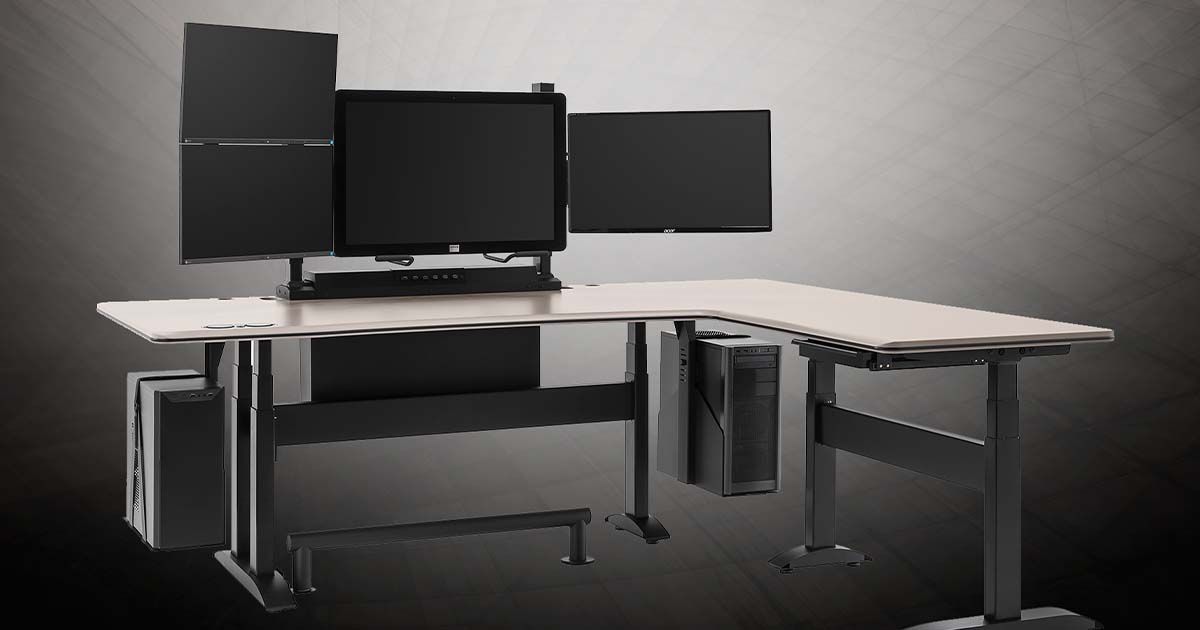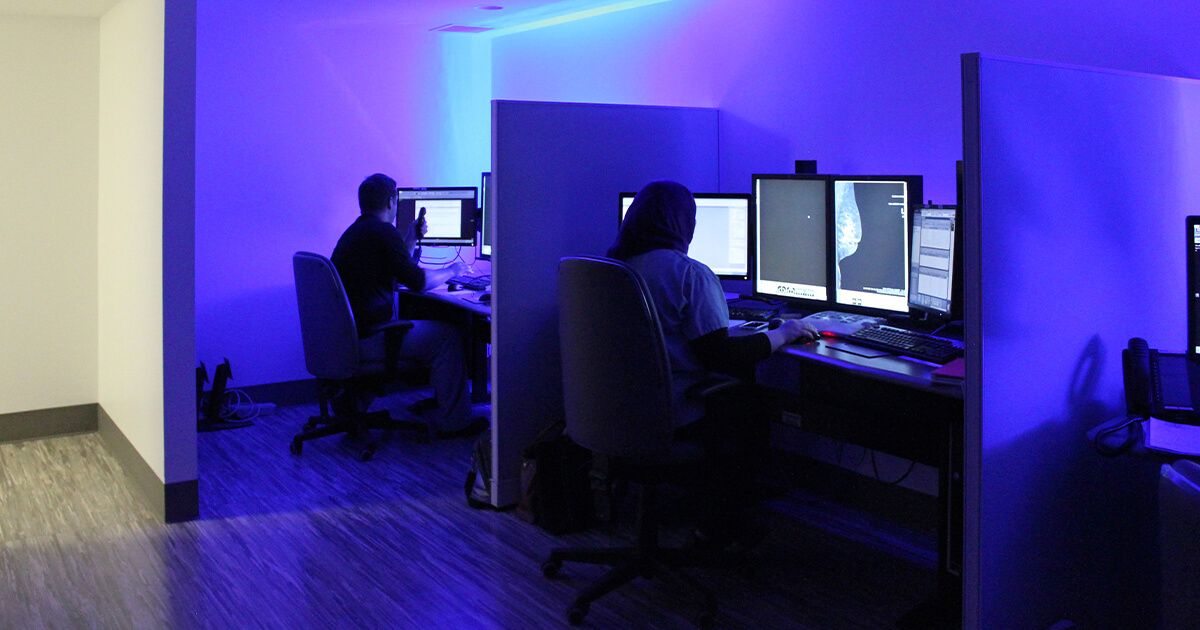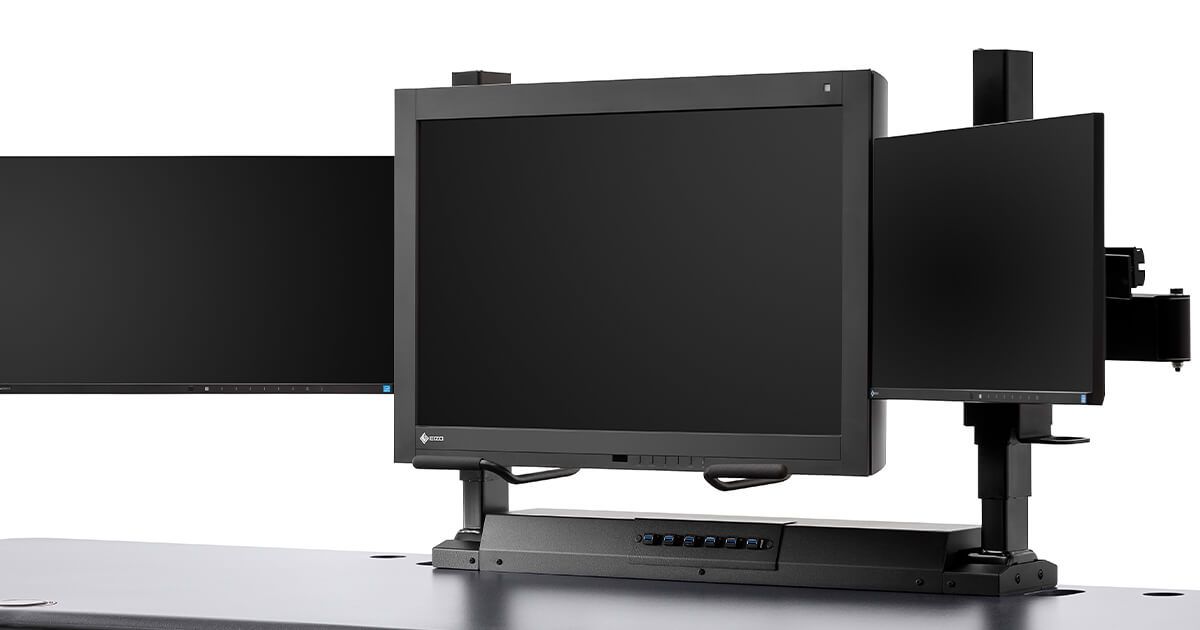
We collect basic website visitor information on this website and store it in cookies. We also utilize Google Analytics to track page view information to assist us in improving our website.

Radiologists are no strangers to the challenges posed by long hours of sitting. It's a stark reality in today’s healthcare landscape, and it's sparking a growing conversation about the need for ergonomic solutions.
In this blog post, we'll explore how the sedentary nature of radiology affects radiologists’ health, and the rise of sit-to-stand desks as a potential remedy.
At RedRick Technologies, we design and develop ergonomic workspaces for healthcare professionals that include workstations, monitor mounting solutions, accessories, and peripherals. We also provide ergonomic design services that help organizations implement ergonomic principles for improved space design and functionality. Get in touch and let’s find ways to improve the ergonomic functionality of your workspace.
Radiologists face the challenge of prolonged periods of sedentary work, which, despite its necessity, carries significant health risks.
The impact of a sedentary lifestyle is far-reaching, affecting various aspects of physical and mental health, including:
Extended sitting can lead to the weakening and atrophy of large leg and gluteal muscles, crucial for walking and stability. This muscular degradation heightens the risk of injuries, including falls and strains during physical activity.
Living a sedentary lifestyle impairs the body’s ability to efficiently digest fats and sugars, leading to their accumulation as body fat. This is true even for those who engage in exercise but spend substantial time sitting.
The hips and back suffer from prolonged sitting. The shortening of hip flexor muscles can lead to hip joint issues, while the spine may experience compression and premature degeneration, especially with poor posture or inadequate ergonomic support. This can result in significant pain and reduced mobility.
Heart disease and diabetes are notably linked to extensive sitting. Studies reveal a stark increase in the risk of heart disease and stroke for individuals who sit for extended periods. Similarly, the risk of diabetes skyrockets due to increased insulin resistance caused by inactivity.
The links between prolonged sitting and mental health issues like anxiety and depression are becoming clearer. Lack of physical activity can deprive individuals of the mental health benefits of exercise.
Emerging research suggests a connection between extended sitting and the risk of certain cancers, including lung, uterine, and colon cancers.
In response to these concerns, national and international health guidelines, including those from the World Health Organization, now advocate for reducing or breaking up sedentary time.
This is where the role of ergonomic workstations, such as standing or sit-to-stand desks, contributes to the solution.
Standing desks and sit-to-stand desks are two types of workstations designed to reduce the amount of time spent sitting.

Research on the health benefits of sit-to-stand desks, especially as a tool to counteract sedentary work habits, is still in its infancy. With the rise in mainstream interest over recent years, more resources are being allocated to study their effectiveness.
To date, there is minimal evidence to confirm that standing more at work fully negates the negative effects of a sedentary lifestyle. However, the health risks associated with prolonged sitting, such as obesity, cardiovascular disease, and increased overall mortality, are well-established.
Contrasting with the limited clinical evidence, subjective reports from sit-to-stand desk users paint a more positive picture. A study published in the British Medical Journal highlighted that interventions like height-adjustable desks led to improvements in well-being, stress, vigor, and lower extremity pain. Users also reported feeling more energized, focused, and productive when incorporating standing into their workday.
The clear risks posed by sedentary lifestyles underscore the importance of breaking up sitting time with frequent movement — which is exactly what a sit-to-stand workstation setup offers.
Experts say that simple activities like standing during phone calls, using a standing desk, or taking short walks every hour can help maintain muscle tone, improve blood circulation, and enhance overall mental and physical well-being, helping to counteract the negative effects of sitting.
While more research is specifically needed on the impact of sit-to-stand or standing desks on radiologists, the general trend suggests that these ergonomic solutions offer a way for radiologists to integrate more movement into their day. This is a benefit that can extend to all workers who spend significant portions of their day sitting.
While the scientific community has yet to reach a consensus on the definitive health benefits of sit-to-stand and standing desks, the anecdotal benefits and the well-documented risks of a sedentary lifestyle highlight the potential of these ergonomic solutions.
For radiologists and similar professionals, incorporating elements that encourage movement, like sit-to-stand desks, could be a significant step towards mitigating the health risks associated with prolonged sitting.
At RedRick Technologies, we recognize the unique demands of healthcare professionals, particularly radiologists, who spend extensive periods in a sedentary position. Our commitment to addressing these challenges is evident in our range of ergonomic workspaces, designed to improve comfort, functionality, and overall health.
A key feature of our workstations is their height adjustability. Every RedRick workstation is designed to accommodate a range of heights, from 24 to 49.5 inches, or from 22-48 inches above the floor.
This flexibility not only meets but exceeds the ANSI BIFMA standards (22-48 inches), ensuring that every user can find their optimal working height.
Understanding the varied and often heavy equipment used in radiology, our sit-to-stand workstations are engineered to lift heavy loads without compromising stability or functionality.
Our expertise extends beyond workstations. At RedRick Technologies, we offer a complete suite of solutions, including monitor mounting options, a variety of accessories, and peripherals, all tailored to enhance ergonomic efficiency.
Each product is designed with the specific needs of healthcare professionals in mind, ensuring that every aspect of their workspace supports their health and productivity.
And since each workspace has its unique challenges and requirements, we provide specialized ergonomic design services. Our team works closely with clients to understand their specific needs and to devise solutions that best address those needs.
We invite healthcare professionals and organizations to get in touch with us to explore how we can enhance the ergonomic functionality of their workspaces. Whether it's customizing workstation configurations or developing comprehensive ergonomic strategies, our goal is to create work environments that are not only efficient and comfortable but also conducive to the well-being of healthcare professionals.
Height adjustable desktop (standard/critical feature)
Our recommended/standard range of adjustment is 24-49.5” above the floor
ANSI BIFMA standard of 22-48” is also available
The size and shape of the desktop are limitless and determined by physical space available, computer hardware to be hosted, and user preference.
Height adjustment (standard/critical feature)
Motorized height adjustment providing 12” of vertical range
All monitors adjust simultaneously
Virtually any monitor configuration can be accommodated
Focal distance adjustment (standard/critical feature)
Effortless manual adjustment, found to be the most intuitive and easy-to-engage method, providing 16” of horizontal forward/back range as well as 60 degrees of side-to-side swivel
Virtually any monitor configuration can be accommodated
Our monitor mounts can handle the heaviest monitor setups. These monitor mounts are designed to accommodate large, high-resolution displays and multiple screens for demanding tasks.
Unlike traditional “split-level” or “keyboard tray” models, RedRick’s mounts allow for single-work-surface solutions that retain maximum usable space, while providing superior, intuitive, and easy ergonomic adjustment.
At RedRick Technologies, we design and develop ergonomic workspaces for healthcare professionals that include workstations, monitor mounting solutions, accessories, and peripherals. We also provide ergonomic design services that help organizations implement ergonomic principles for improved space design and functionality.
Get in touch and let’s find ways to improve the ergonomic functionality of your workspace.

Radiology, a field integral to modern healthcare, requires practitioners to have extensive knowledge in anatomy, pathology, physics, image interpretation, and more.
However, there’s one important subject that often gets overlooked in the education of future radiologists: ergonomics.
This oversight is not due to a lack of awareness. Most radiology students understand the significance of ergonomics, given their in-depth study of the human body. Yet, there’s a gap between this awareness and the practical use of ergonomic practices in their daily routines as students and radiology residents.
The implications of this gap are significant. Considering the high incidence of musculoskeletal disorders among radiologists, it’s clear that ergonomics is not just a matter of comfort but of professional necessity.
This article sheds light on the critical importance of ergonomic workstations in radiologists’ training and daily activities. We will delve into why ergonomic practices are essential, not only for the current well-being of radiologists but also for their long-term health and the accuracy of their diagnoses.
At RedRick Technologies, we design and develop ergonomic workspaces for healthcare professionals that include workstations, monitor mounting solutions, accessories, and peripherals. We also provide ergonomic design services that help organizations implement ergonomic principles for improved space design and functionality. Get in touch and let’s find ways to improve the ergonomic functionality of your workspace.
Radiology education is extensive and demanding. It involves at least four years of medical school, followed by a residency in radiology lasting four to five years, often with additional years for those who specialize further.
This professional path is marked by long and irregular hours, including nights and weekends, particularly on call. Radiologists must be consistently available for urgent imaging studies, which can be both physically and mentally taxing.
The day-to-day responsibilities of a radiologist involve analyzing a high volume of complex imaging studies, requiring sustained concentration and meticulous attention to detail.
This demanding nature of radiology practice has significant ergonomic implications, particularly for those in training and in active practice:
A substantial amount of time for radiology trainees and practising radiologists is spent in reading rooms, analyzing imaging studies for extended periods. This usually involves prolonged sitting and intense focus on computer monitors, leading to potential musculoskeletal strain and fatigue. Ergonomically designed workstations are essential in these settings to prevent such pressure and support physical well-being.
The use of a mouse and keyboard for extended periods can lead to repetitive stress injuries. Incorporating ergonomic accessories, such as trackballs, ergonomic mice, and keyboards, is critical in reducing the risk of these injuries.
The detailed nature of radiological work, especially when interpreting high-resolution images, puts a significant strain on the eyes. Implementing ergonomic solutions like optimal monitor height, appropriate distance, and ambient lighting can help alleviate eye strain and fatigue.
The high cognitive load inherent in radiology can be worsened by physical discomfort due to poor ergonomics. An environment that is ergonomically sound not only mitigates physical stress but also supports better cognitive functioning, thereby enhancing the overall quality of healthcare provided.
This underlines the importance of integrating ergonomic principles into radiologists’ education and daily practice, ensuring their well-being and efficacy in delivering the highest standard of patient care.

Investing in ergonomic solutions, especially in reading rooms, and imparting education about ergonomics to radiologists in training is not just a good practice — it’s necessary for healthcare facilities and educational institutions.
Here are a few of the ways that ergonomics has far-reaching impacts on healthcare quality, financial sustainability, and the well-being of future radiologists:
Diagnostic Precision and Efficiency: Comfort and focus are important in radiology since the accuracy of image interpretation can significantly affect patient outcomes. Ergonomically designed reading rooms contribute to this precision and efficiency, directly impacting the quality of patient care.
Learning and Cognitive Function: For educational institutions, ergonomic environments are more than just comfortable spaces. They are crucial in enhancing the learning experience, enabling students and residents to absorb complex information better and develop professional skills.
Reduction in Musculoskeletal Disorders: The health benefits of ergonomic workstations are clear. By reducing the incidence of musculoskeletal disorders, healthcare institutions safeguard the well-being of their radiologists and mitigate related costs, such as those from absenteeism and potential compensation claims.
Job Satisfaction and Retention: An ergonomic workplace reflects an institution’s dedication to its staff and residents’ health. This commitment can increase job satisfaction, morale, and loyalty, enhancing retention rates and attracting top talent.
Long-term Career Sustainability: Introducing ergonomics early in radiology training encourages adopting good practices throughout one’s career. This foresight helps prevent burnout and early retirement due to health issues, ensuring long-term career sustainability.
Institutional Reputation: Institutions prioritizing ergonomic solutions are often perceived as progressive and caring. This perception enhances their reputation, making them more attractive to prospective residents and professionals.
Long-term Financial Benefits: While there are upfront costs in implementing ergonomic solutions, the long-term financial returns are significant in the form of lowered healthcare costs, reduced absenteeism, improved productivity, and decreased staff turnover.
These points underscore the importance of ergonomic training and equipment in radiology. It’s an investment that pays dividends in terms of healthcare quality, financial savings, and the well-being of medical professionals.
As the field of radiology evolves, so does the need for future radiologists to be well-versed in ergonomic principles. Essential ergonomic practices and considerations for medical students aspiring to specialize in radiology include:
Understanding ergonomics begins with recognizing the importance of posture, a fundamental aspect often overlooked in the rigorous training of radiologists. This involves knowledge of ergonomic seating, optimal desk height, and chair adjustments, tailored to support the body's natural alignment.
Aspiring radiologists must learn not only how to maintain proper posture while interpreting scans but also the value of alternating between sitting and standing, which is key in reducing the physical toll of long hours spent at workstations.
Integrating standing desks or adjustable workstations allows for regular changes in posture throughout the day, alleviating the risk of prolonged strain on the back, neck, and eyes. These are common problem areas for radiologists, often leading to chronic discomfort or injury.
By adopting ergonomic practices early on, future radiologists can prevent injury and improve their focus and efficiency from the start.
The placement of monitors is important in reducing eye strain and glare. Future radiologists should know how to set up their monitors at the ideal angle and distance. The role of ambient lighting in minimizing eye fatigue and headaches is also essential.
A well-designed radiology workstation that follows ergonomic principles is a game-changer. This includes adjustable desks, suitable footrests, and an efficient equipment layout to promote both comfort and efficiency.
The sedentary nature of radiology work means taking regular breaks is important. This is a habit more than a skill, but it helps to start practicing it as early as possible. Including physical activities or exercises to counteract sedentariness is even better.
Ergonomic accessories, such as ergonomic mice and keyboards can significantly reduce the risk of repetitive strain injuries. Aspiring radiologists should consider these products essential tools of the trade.
Future radiologists should know the risks of repetitive strain injuries common in radiology, like carpal tunnel syndrome, and strategies to prevent them. These types of injuries can seriously impact a radiologist’s career, potentially cutting that career short.
Ergonomics is not a one-size-fits-all approach. Knowing how to adjust based on your needs and body type is an excellent skill for aspiring radiologists.
At the core of our philosophy is the understanding that every workspace (and each radiologist) has unique needs. This drives our commitment to delivering customized, user-friendly solutions, particularly in complex environments like radiology reading rooms and learning spaces.
Our design proposals and product offerings are tailor-made, aligning perfectly with each client’s requirements. This customization is critical in settings like radiology reading rooms, where the precision and accuracy of diagnoses heavily rely on the comfort and efficiency of the workspace.
A key principle in our designs is prioritizing ease of use. We understand that the best ergonomic solutions integrate seamlessly into the daily routines of professionals.
To this end, our products are adjustable, intuitive, and robust. This durability ensures that they stand up to the demands of a busy radiology department, providing prolonged comfort and support over time.

Height adjustable desktop (standard/critical feature)
Our recommended/standard range of adjustment is 24-49.5” above the floor
ANSI BIFMA standard of 22-48” is also available
The size and shape of a desktop are limitless and determined by physical space available, computer hardware to be hosted, and user preference.
Height adjustment (standard/critical feature)
Motorized height adjustment providing 12” of vertical range
All monitors adjust simultaneously
Virtually any monitor configuration can be accommodated
Focal distance adjustment (standard/critical feature)
Effortless manual adjustment, found to be the most intuitive and easy-to-engage method, providing 16” of horizontal forward/back range as well as 60 degrees of side-to-side swivel
Virtually any monitor configuration can be accommodated
Our monitor mounts can handle the heaviest monitor setups. These monitor mounts are designed to accommodate large, high-resolution displays and multiple screens for demanding tasks.
Unlike traditional “split-level” or “keyboard tray” models, RedRick’s mounts allow for single-work-surface solutions that retain maximum useable space, while providing superior, intuitive, and easy ergonomic adjustment.
At RedRick Technologies, we design and develop ergonomic workspaces for healthcare professionals that include workstations, monitor mounting solutions, accessories, and peripherals. We also provide ergonomic design services that help organizations implement ergonomic principles for improved space design and functionality. Get in touch and let’s find ways to improve the ergonomic functionality of your workspace.